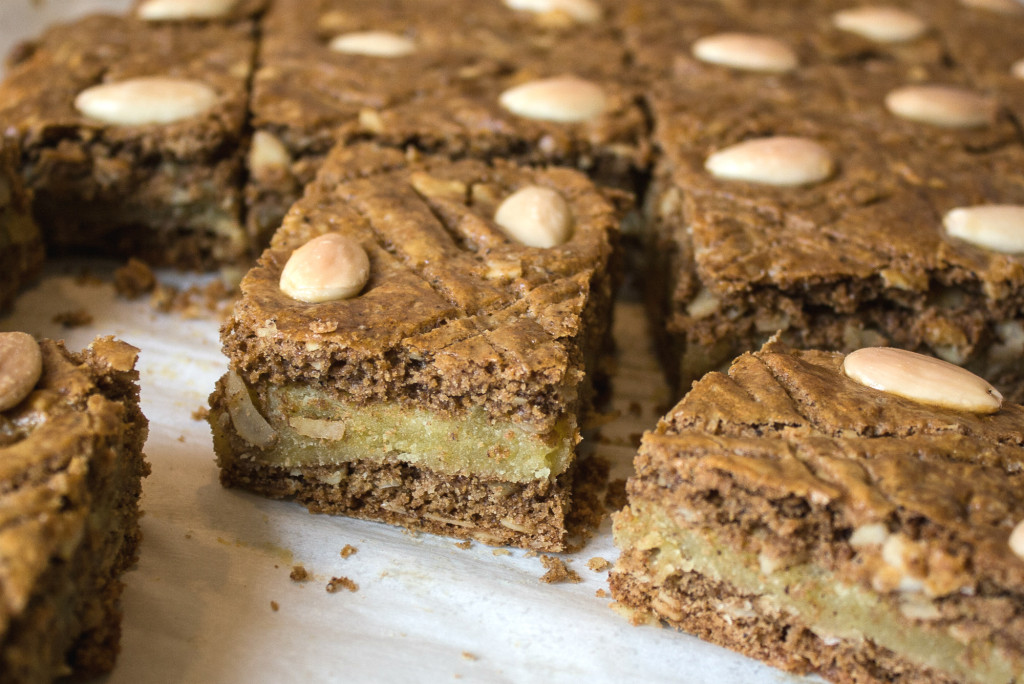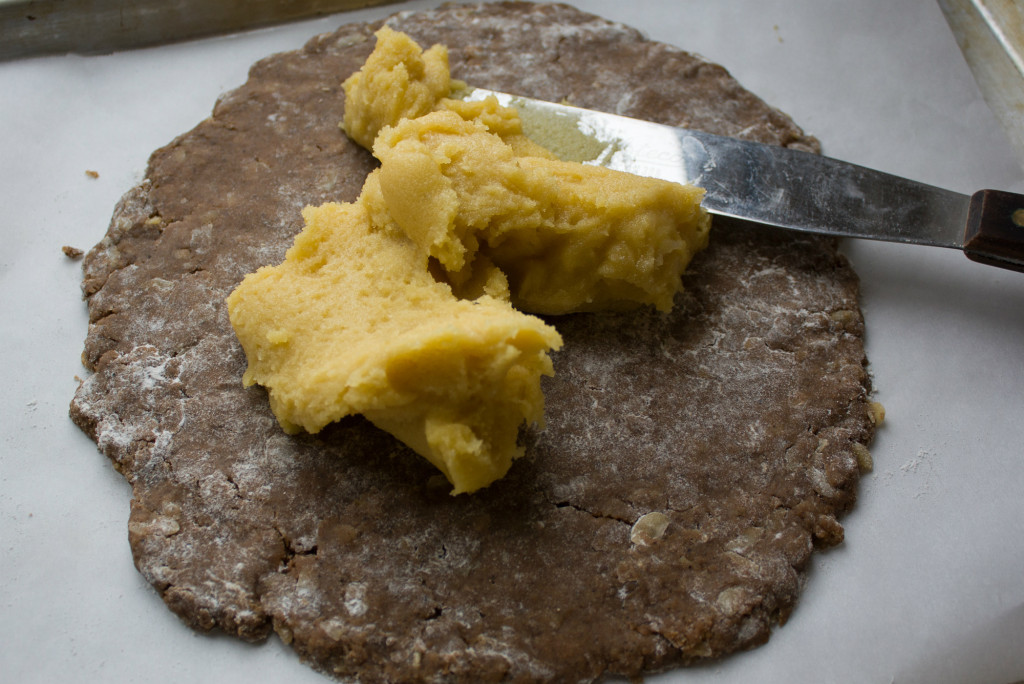Gingerbread Is A Holiday Tradition Older Than Santa
By Michael Krondl (Zester Daily) –
Long before there were Christmas lights, cards, trees or even Santa Claus, and before there were Christmas cookies, richly frosted Yule logs or candy canes … there was gingerbread.
At least since the Middle Ages, what we loosely call gingerbread — richly spiced cookies, wafers and honey breads — has been part of the winter holiday season. There’s a street in the medieval heart of Prague named after spiced honey cake makers. And we know that the Bavarian city of Nürnberg (Nuremberg) was a gingerbread exporter in the 14th century, as was the Dutch city of Deventer not much later. Ever since, the scent of Christmas has been that of gingerbread.
In much of central and northern Europe, the holiday season stretches for several weeks, beginning on St. Nicholas Day (Dec. 6) and ending a month later on Epiphany (around Jan. 6). St. Nicholas was a semi-mythical 4th century Middle Eastern bishop, the sometime patron saint to merchants, sailors and thieves. In his modern incarnation, he is mostly known for rewarding good children and punishing the bad.
The Netherlands Santa: An old bishop and his servant

In the Netherlands, the white-bearded bishop (known there as Sinterklaas) arrives each year (supposedly) from Spain, accompanied by a black-faced companion named Black Pete. The tradition of an African servant seems to derive from Holland’s not altogether savory colonial history. That it endures is baffling to most outsiders even if the Dutch insist that it is all just good fun.
America’s Santa Claus is largely derived from Sinterklaas, though he has no sidekick, is much jollier (perhaps because of the remittances from starring in Coca Cola ads?) and hails not from sunny Spain but from the North Pole.
Dutch bakers and their aromatic dough

Whereas edible Santas are usually made out of chocolate, Saint Nicks come in the form of gingerbread; these may be the original gingerbread men. Dutch bakers follow medieval tradition by continuing to press richly aromatic dough into elaborately wooden molds carved in the shape of angels, animals and hearts, but most especially Sinterklaas. Since the large cookies are the mirror image of the mold, the Dutch named them speculaas — derived from the Latin word for a mirror — a term that they now use for any kind of gingerbread.
This shape, along with the distinctive spicy scent, announces the season. The winter treats are richly flavored with exotic, Eastern spices. In the Middle Ages, it was widely believed that spices such as cloves, nutmeg and cinnamon originated in the Garden of Eden, which was supposedly located somewhere east of the Holy Land. Accordingly, martyred saints, or their remains, were believed to emanate sweet and fragrant spice — and, naturally, so did their gingerbread images.
Moreover, some of these original edibles were literally precious because of the high cost of the Eastern aromatics. Imported from half the world away by ship, camel and ox cart, the spices were both expensive and rare. Accordingly, how much and which of these costly seasonings ended up in the cakes depended on the time and place. The British were fond of ginger, so we call our spice cakes “gingerbread.” In Germany and other parts of central Europe, the local “gingerbread,” or Lebkuchen, often contained no ginger whatsoever. The famous Nürnberg interpretation was made with cloves, nutmeg, cinnamon and cardamom. And the cheap versions, sold at country fairs, were concocted of rye flour and honey and were barely spiced at all.
In the days when sugar was an elite treat, the peasantry often grated this inexpensive Lebkuchen on their porridge in lieu of sugar. Meanwhile, the French have their own spice bread, or pain d’épice, and add anise to the usual sweet spice masala.
Many varieties of spicy treats
Yet no one is quite as obsessed with gingerbread as the Dutch. Food historian Peter Rose has documented some 47 varieties of speculaas, and that doesn’t even include the pepernoten (spice cookies) handed out by black-faced Netherlanders on St. Nicholas Day.
Nobody can touch the Dutch when it comes to the quantity of spice in their gingerbread. This too is part of a colonial legacy, when the little country controlled the world supply of nutmeg and cloves. Today, the Dutch make cheese studded with whole cloves and often include nutmeg along with salt and pepper when setting the table. Not surprisingly, some speculaas has the kick of a cinnamon red hot. Most Netherlanders wouldn’t be able to tell you what goes into speculaas spice, since they buy the mixture already mixed, but cloves and nutmeg are typical, as is white pepper.
No matter the recipe, it seems purposely made to ward off Holland’s damp winter chill. A bite of sweet, intensely spicy speculaas sends a warm glow throughout your body. It’s not hard to understand why this was once thought an edible morsel of paradise.
Speculaas With Almond Filling
This recipe is loosely adapted from the Dutch culinary historian Christianne Muusers. She suggests putting a little rose water into the almond filling, which adds yet another layer of aroma to this profoundly spiced treat. Though just about everyone in Holland will just reach for a package of prepared speculaas spice, it’s worth grinding your own spices — they’ll be much more intense. I like to use muscovado, a natural brown sugar, in the dough, although another brown sugar will certainly work.
Prep time: About 45 minutes
Baking time: About 30 minutes
Total time: 1 hour and 15 minutes
Yield: 2 dozen pieces of speculaas
Ingredients
Spice Dough:
- 2 cups all-purpose flour
- 3/4 cup natural demerara sugar (or substitute light brown sugar)
- 1 tablespoon plus 1 teaspoon ground cinnamon
- 1 teaspoon grated nutmeg
- 1 teaspoon ground cloves
- 1/2 teaspoon ground white pepper
- 3/4 teaspoon ground ginger
- 1/2 teaspoon ground cardamom seed
- 1/2 teaspoon salt
- 1/2 teaspoon baking powder
- 1/2 teaspoon baking soda
- 1/2 cup plus 2 tablespoons (1 1/4 stick) cold, unsalted butter, cut into 1/2-inch pieces
- 3 1/2 ounces (about 1 cup) sliced almonds
- Grated zest of 1 lemon
- 1 large egg
- 2 tablespoons heavy cream
Almond filling:
- 10 ounces almond paste
- 1 egg
- 1 tablespoon rose water
- 1 lightly beaten egg for brushing
- 2 dozen to 3 dozen whole blanched almonds for decorating
Directions
1. To make the dough, combine the flour, demerara sugar, spices, salt, baking powder and baking soda in a food processor. Pulse to combine. Add the butter and pulse until the butter pieces are about as big as flakes of oatmeal. Transfer mixture to a bowl. Stir in the sliced almonds and lemon rind. Stir together the 1 egg and the cream. Sprinkle this over the flour mixture, then gently toss this mixture with your hands until you have a rather dry dough. If it doesn’t hold together, add another tablespoon or two of cream. It should be about the consistency of pie dough. Cover and refrigerate overnight; this allows the flavor of the spices to infuse the dough.
2. Make the filling by putting the almond paste into a food processor and gradually adding the egg and then the rose water, teaspoon by teaspoon. You need the filling to be spreadable but not runny. This may be made a day ahead and refrigerated.
3. When you’re ready to bake the speculaas, set your oven to 350 F. Take half the dough and roll it out on a floured board to about a 1/4-inch thick round or rectangle. (If it feels too hard, let it sit out for half an hour before rolling.) Transfer this to a parchment-lined baking sheet. Use plenty of flour when you’re rolling out the dough, and don’t worry if it breaks as you are transferring it — you’ll most likely need to cut it and patch it anyway to form an even round or rectangle.
Almond paste filling
4. Spread the almond paste over the dough, leaving a border of about 1/4 inch naked. Roll out the rest of the dough, drape it over the filling, and even out the dough to make a smooth edge. Brush generously with lightly beaten egg, using the brush to smooth out any cracks and crevices. Using a knife, trace diamonds over the surface. Decorate the top with whole, blanched almonds.
5. Bake for 20 to 30 minutes in the preheated oven until firm and a rich brown. Make sure to cut it into pieces before it cools completely. I usually cut it into squares or diamonds of about 2 inches.


Leave a Reply
You must be logged in to post a comment.